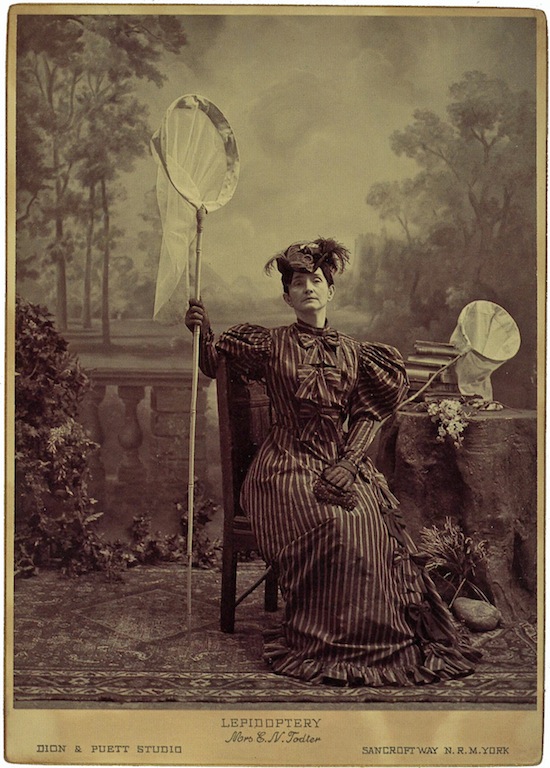
Mrs. E.N. Todter by Dion & Puett Studio
Mrs. E.N. Todter, a smartly dressed Victorian lady, holds her head high and brandishes her butterfly net like an imperial banner. She is an amateur natural scientist specializing in lepidoptery and a member of The Ladies’ Field Club of York (in England), and she is having her portrait taken in a well-appointed studio.
Other associates of the esteemed society have all presented themselves for similar pictures: Mrs. Herbert Fowler, an anthropologist; Henrietta Swanson, whose interests lie in birds; Arabella Bell, expert in conchology (a now archaic branch of study devoted to sea shells); and Miss Amelia West, a botanist. No expense has been spared, and as if to outdo her colleagues, each woman poses in a meticulously simulated setting complete with three-dimensional props to evoke the environment in which her investigations occur. The stone balustrade behind Mrs. Todter leads to a painted backdrop of a garden butterfly habitat of magnificent proportions.
The photograph, like the other seven in the series, is entirely fake, part of a fictional project by the American artists Mark Dion and J. Morgan Puett—styled here the “Dion & Puett Studio”—created in 1999 for the National Railway Museum in York, where the portraits were displayed alongside the ladies’ mobile laboratory in a teak baggage car built in the 1890s by the Great Northern Railway. I missed the show but I do have the “catalogue,” eight postcard photographs slotted into a leporello.
The models (there is also a man in the guise of their “trusted porter”) were all contemporary art curators working in Britain, making the series both an inside joke and an indirect celebration of the under-acknowledged influence of dynamic women in the art world. Each curator agreed to play the part of a scientifically minded Victorian lady, and threw herself into the role with gusto; the portraits are entirely believable. In reality, Mrs. E.N. Todter, who never existed, is Frances Morris, a curator at the Tate Gallery, as it was then called. She was recently appointed as the new director of Tate Modern. Amelia West was played by Iwona Blazwick, director since 2001 of the Whitechapel Gallery in London, and Arabella Bell by Gilda Williams, author in 2014 of the indispensable How to Write about Contemporary Art.
For the intrepid imaginary ladies of the field club, doing battle in clothes like armour, nature is a domain that can be observed, subdivided, classified, and labeled—lepidoptery, geology, ornithology, paleontology—and Dion believes that we are still inclined to rely on such over-simplifications. According to remarks he made to the press at the time, he liked the fact that the detail-obsessed trainspotters who frequent the railway museum would be bemused by the anomalous presence of this feminist imposture. It’s the artists’ equally obsessive attention to the niceties of late Victorian studio portraiture, though, which makes these illusions so pleasurably convincing.
See all Exposure columns


Comments [1]
05.29.16
09:38